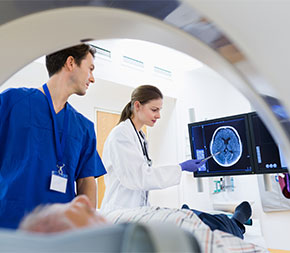In this Article


Written and reported by:
Terry Ward
Contributing writer
Doctors hardly work alone. They rely on many other professionals to gather information about patients in order to deliver the best care.
One tool doctors have when it comes to making diagnoses is medical imagery, and this is where radiology technologists and ultrasound technologists play a vital role.
Radiology technologists and ultrasound technologists both work in high-touch, high-technology fields with growing demand and require specialized training to make the medical images of patients that doctors use in diagnoses and treatment plans.
“To pursue a career in any of these fields, one must have an interest in the science of imaging and enjoy working in a field with continual advances in technology, along with a strong desire to care for human beings in all walks of life,” says Teresa L. Vatterott, MAEL, R.T.(R)(CV)(CI)(ARRT), initial certification supervisor, education requirements, with the American Registry of Radiologic Technologists (ARRT).
How the Careers Differ
The biggest difference between radiology technologists and ultrasound technologists is the technology they use to create images.
Radiology technologists create images of patients’ bodies using technology that primarily requires radiation, including:
- X-ray:
- Images commonly used to look at bones and joints
- Magnetic resonance imaging (MRI):
- A procedure used to create images of organs in the body
- Computed tomography (CT):
- Scans that allow doctors to see a cross-section of a body part
- Fluoroscopy:
- A procedure that uses contrast dyes to show movement through the body
Ultrasound technologists, also called sonographers, use only one type of equipment: an ultrasound machine. This technology emits high-frequency sound waves to create body images, with no radiation involved.
Radiology and ultrasound testing can overlap, since both produce images, but some tests are better at capturing different things in the body. For instance, ultrasound captures images in real time and can show movement within the body. X-rays, on the other hand, produce static images.
How the Careers Are Similar
The images that radiology technologists and ultrasound technologists create are vital for the decisions that physicians make about treatment. They can be used to:
- Detect blockage in the blood supply to the brain and prevent a stroke
- Evaluate the body’s circulatory system and detect blood clots
- Diagnose joint problems and evaluate injuries like broken bones
- Spot tumors
Before seeing a patient, ultrasound technologists and radiology technologists will look at the physician’s orders to make sure they align with the patient’s chart.
Then the actual patient interaction and imaging begin.
Compassion and Sensitivity Required
Because of the sensitive nature of many medical images, radiology technologists and ultrasound technologists must have a calming bedside manner. Sensitive situations can arise when a patient or family member wants to gauge what a technician is seeing or when they are fearful and upset. At times like these, a technologist must stay cool and maintain a sensitive demeanor.
“It’s important to have that ability to connect with a person who may feel nervous,” says Kevin Rush, senior director of credentialing operations for ARRT. “They may not understand what’s about to happen, so you have to discern if someone is afraid or just may not understand what’s happening.”
Workplaces for Radiology and Ultrasound Technologists
Radiologic technologists and ultrasound technologists can work in the same medical settings, including:
- Hospitals
- Outpatient clinics
- Urgent care centers
- Operating rooms
- Emergency rooms
And although radiology and ultrasound technologists may see patients for different reasons, there can be a lot of overlap in the patients themselves—men, women, and children of all ages.
Education Requirements
Both careers require a minimum two-year associate degree and clinical training, but you can also earn a bachelor’s degree in these fields.
Hands-on clinical internships are part of both degrees, and students in both programs will take some of the same classes, including:
- Anatomy
- Biology
- Chemistry
- Mathematics
- Patient positioning
- Patient safety
Here’s a look at courses specific to each field, whether students earn an associate degree or a bachelor’s degree.
Courses Specific to Each Profession
Radiology Technologist
- Radiologic theory
- Radiation physics
- Radiologic procedures
- Radiologic protection
- Specialized clinical imaging
Ultrasound Technician
- Principles of general sonography
- Ultrasound physics and instrumentation
- Sonography patient care
- Abdominal scanning and pathology
- OB/GYN scanning and pathology
If you pursue a bachelor’s degree, you could earn a Bachelor of Science with a concentration in radiography or sonography. Other possible degrees include a Bachelor of Science in Medical Imaging and a Bachelor of Science in Radiologic Sciences.
If you’re pursuing a four-year degree in either field, your coursework will include:
- Healthcare ethics
- Epidemiology
- Conflict resolution in healthcare
- Health policy
After Education Training
Clinical rotations are the cornerstone of education for ultrasound technologists and radiologic technologists.
Students should expect to spend up to six months training in a variety of settings, from specialty clinics to large hospitals, using a variety of equipment. You’ll see patients with a range of health problems to get the breadth of real-world training you’ll need. Expect to work under a preceptor, a professional who oversees training at a medical facility.
3 Crucial Skills
Your clinical training will drive home the importance of three crucial skills for successful radiology technologists and ultrasound technologists:
- Precision:
- You’ll need to carefully follow instructions to get the clear images a physician will need to diagnose or prescribe treatment for a patient.
- Interpersonal Skills:
- You’ll need compassion to work with patients who may be fearful and need extra guidance and patience to produce needed images.
- Technical Skills:
- You’ll need to be able to operate highly technical equipment with the skill and speed needed to handle a stream of patients.
Certification and Licensure
License and certification requirements vary for radiology and ultrasound technologists. While not always required by law, many employers look for certification when hiring.
Certification can help you stand out in a field of applicants, open doors to advancement, and increase your salary.
“There’s always the opportunity to keep growing while you’re working, to keep continuing your education,” says Falguni Patel, RDMS, RVT, RMSKS, a vice-chair of the American Registry for Diagnostic Medical Sonography Council (ARDMS).
Ultrasound Technologists
Currently, New Hampshire, New Mexico, North Dakota, and Oregon are the only states that require ultrasound technologists to be licensed.
The American Registry of Diagnostic Medical Sonography offers a number of optional specialty certifications for ultrasound technologists. All of them require a basic exam, the Sonography Principles and Instrumentation Examination, plus a specialty exam related to each certification:
- Registered Diagnostic Medical Sonographer (RDMS)
- Registered Diagnostic Cardiac Sonographer (RDCS)
- Registered Vascular Technologist (RVT)
- Registered Musculoskeletal Sonographer (RMKS)
Radiology Technologists
When it comes to radiology technologists, state licensing and certification requirements are a hodgepodge. Some states don’t require a license, some only require certification, and some require both.
The American Registry of Radiologic Technologists (ARRT) offers certifications for technologists who have an associate degree or higher from an accredited program, plus two certifications for ultrasound technologists:
- Magnetic Resonance Imaging
- Nuclear Medicine Technology
- Radiation Therapy
- Radiography
- Sonography
- Vascular Sonography
Here are state licensing and certification requirements for radiology technologists:
No License or Certification Required
ARRT Certification Only Required
State License and ARRT Certification Required
Salaries and Job Outlook
The median annual salary for a radiology technologist is $73,410 per year, according to the U.S. Bureau of Labor Statistics, with 5.5% growth projected through 2032.
By comparison, ultrasound technologists make a median salary of $84,470, or about 9% more. That may be because there’s more demand for sonographers, whose profession is expected to grow by 14.3% through 2032.
“There are so many growth opportunities in this field,” says Patel. “You can start like a regular sonographer and, depending on what your strength is and what you want to specialize in, you can become a preceptor, a mentor, you can go into leadership.
“It’s a great career and there’s not much education involved,” she says. “You make such a good living and it’s so rewarding. You have nothing to lose.”
When it comes to radiology technologist careers, Rush says “there is a lot of room for growth” because there are so many specialties to pursue, both in terms of imaging and medical condition.
“The population is living longer and there’s growth for the other modalities as we continue to find less invasive ways to determine if someone has an illness or injury,” he says.
Which Career Is Right for You?
One of the key things to keep in mind when considering these career paths is the human element both involve. The images you create are attached to people, and your work can bring joy, relief, apprehension, and a host of other emotions.
“Consider your ability to deal with the human condition,” says Rush. “If you work in a small town, be prepared that you may be interacting with someone you know or the parent of someone you know. Maybe your favorite teacher.”
“You have to be able to deal with people when they’re not necessarily at their best,” he says, “and often through no fault of their own.”
“You have to be professional and personal at the same time,” adds Patel. “You deal with a lot of emotions from patients and caretakers, and you have to keep that straight face and still be able to comfort them.”
The rewards of both careers, however, are many.
“It’s an eight-hour job that requires being on-call and weekend work, but it feels good that I’ve made a difference when I’m done,” says Patel. “These images are actually saving people’s lives out there. I’ve been doing it all these years and I’m still not bored.”

With professional insight from:
Teresa L. Vatterott, MAEL, R.T.(R)(CV)(CI)(ARRT)
Initial Certification Supervisor, Education Requirements
American Registry of Radiologic Technologists

With professional insight from:
Kevin L. Rush, R.T.(R)(T)(ARRT), CRA, FASRT
Senior Director, Credentialing Operations
American Registry of Radiologic Technologists

With professional insight from:
Falguni Patel, RDMS, RVT, RMSKS
Vice Chairperson, American Registry for Diagnostic Medical Sonography Council (ARDMS)
You may also enjoy:



